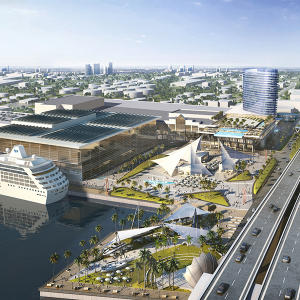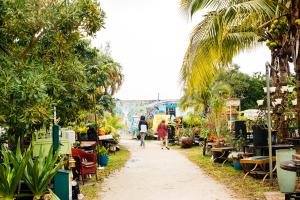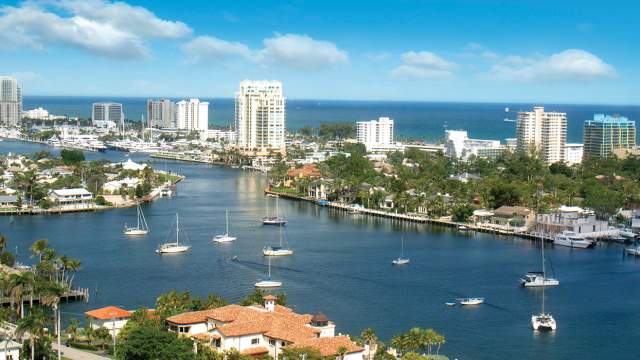@visitlauderdale
Your browser is not supported for this experience.
We recommend using Chrome, Firefox, Edge, or Safari.
Broward County Land Use and Urban Planning
A Delicate Balancing Act
We pride ourselves of being one of the most open and welcoming regions in the country, so we want to welcome more people to experience the beauty and privilege of living in Greater Fort Lauderdale (Broward County).
On the other hand, we want to protect our environment and natural resources. We want to avoid polluting our oceans and canals, also we want to protect our unique Everglades from the continued invasion of urban sprawl.
Finally, no one enjoys sitting in traffic, overcrowded schools and hospitals, or other services (police, fire departments, water, trash pickup) to be overwhelmed; so, we want our infrastructure to grow at pace with the city.
As you can see, we have needs and goals that are in competition with each other, sometimes at direct odds with one another. How do you go about solving those huge puzzles?
Urban planning!
For this purpose, there are “Master Plans” for the development of our living spaces at Federal, State and Local levels. For the coordination of multiple agencies across multiple jurisdictional levels of government Broward County created the Broward County Planning Council: this is an Intergovernmental Coordination group and countywide planning agency, which engages in coordinated long-range planning within the County through its continuing program of working with and assisting state, regional and local governments on matters of mutual concern. The Planning Council, working in concert with state agencies, including the Florida Department of Community Affairs and the Florida Department of Transportation, regional agencies such as the South Florida Water Management District and the South Florida Regional Planning Council, and municipalities, seeks regional solutions to multi-jurisdictional planning issues. This provides an integrated and efficient countywide comprehensive planning approach to protecting and enhancing the quality of life within Broward County.
The U.S. Army Corps of Engineers
 At the Federal level, planning for development of land (urban, rural, protected) begins with the U.S. Army Corps (pronounced “kȯr”) of Engineers. Among its roles and with environmental sustainability as a guiding principle, the Corps team works on waterways to support the movement of critical commodities and services, such as the Intracoastal Waterway and Port Everglades. Also, they prepare communities to reduce the risks of hurricane and storm damage. And from an environmental protection perspective, the Corps is working on projects to clean contaminated sites or degraded ecosystems, such as our Everglades.
At the Federal level, planning for development of land (urban, rural, protected) begins with the U.S. Army Corps (pronounced “kȯr”) of Engineers. Among its roles and with environmental sustainability as a guiding principle, the Corps team works on waterways to support the movement of critical commodities and services, such as the Intracoastal Waterway and Port Everglades. Also, they prepare communities to reduce the risks of hurricane and storm damage. And from an environmental protection perspective, the Corps is working on projects to clean contaminated sites or degraded ecosystems, such as our Everglades.
The Florida Department of Community Affairs
The Florida Department of Community Affairs (or DCA) issues permits for counties to change their growth plans, based on availability of public resources such as water, roads, schools and drainage canals.
The Florida Department of Transportation
FDOT’s primary responsibility is to coordinate the planning and development of a safe, viable, and balanced state transportation system serving all regions of the state. In Broward County the transportation system includes roads, air, rail, seaports, bus transit, and bicycle and pedestrian facilities.
The South Florida Regional Planning Council
The Council serves three counties: Monroe, Miami-Dade, and Broward; 71 municipalities; and 4.3 million residents. Over the next 20 years, the Region is expected to grow to an increasingly diverse estimated population of more than 4.9 million residents. It was created to address “growth-related problems on greater-than local issues, provide technical assistance to local governments, and meet other needs of the communities in each region.”
The South Florida Water Management District
The South Florida Water Management District is responsible with management and protection of water resources in our region. The District's work fits broadly into four categories: Flood control, water supply planning, water quality improvement and ecosystem restoration.
What Are We Doing?
There are 31 municipalities within Broward County, each exhibiting different land use, population and development characteristics. These municipalities vary in size from 13 acres (Lazy Lake) to more than 36 square miles (Fort Lauderdale). Their populations vary, from 24 (Lazy Lake) to approximately 176,013 (Fort Lauderdale). Unincorporated Broward County, with land area dispersed throughout the County, encompasses approximately 11.6 square miles (outside the Conservation Area); the Board of County Commissioners exercises authority in the unincorporated area.
The presence of 32 local governments, as well as numerous special-purpose government entities, can complicate resolving even the simplest planning problems and provides for a challenge in the arena of intergovernmental cooperation and coordination. The Planning Council is the forum for meeting such challenges.
The Council has drawn and abides by certain goals and plans:
 Environmental Protection and Growth Management Department
Environmental Protection and Growth Management Department
The Environmental Protection and Growth Management Department's mission is to safeguard lives, natural resources and property of residents and visitors by providing for natural resource planning, management and protection, planning for appropriate land use/housing patterns and establishing an incident command system and emergency operations plans, enforcing environmental, development and construction regulations and providing for consumer protection. Our business plan addresses the issues and challenges of our current environment, including: changes in demographics and the economy, the potential for natural disasters, increasing use of the internet for retail purchases of goods and services, concerns about land availability, lack of affordable housing and an increase in housing prices, continued violation of environmental laws, and limited financial resources.
Broward County Land Use Plan
The Broward County Planning Council is charged with the responsibility of preparing a countywide land use plan under the Charter of Broward County, Florida. Upon adoption of the Broward County Land Use Plan by the Broward County Commission, it became the official land use plan within the County and is effective within all the County’s local governments. The Charter requires all local land use plans within the County to conform to the Broward County Land Use Plan.
The Land Use Plan establishes the framework for the future development and redevelopment of Broward County and for the provision of facilities and services within the County. All development must be consistent with the uses, the densities and the intensities of this policy plan.
The Broward County Planning Council reviews and makes recommendation to the Broward County Commission on all proposed amendments to the Broward County Land Use Plan. Requests for amendments are reviewed by Council staff, as well as numerous County and regional agencies, to ensure adequate public facilities and services will be in place to serve the proposed land use. Further, environmental agencies review amendments for impacts on our natural resources.
Broward County Trafficways Plan
The Trafficways Plan is the ultimate roadway right-of-way preservation plan for Broward County. To offset the impacts of new development and redevelopment, dedication of right-of- way is required of developing parcels to provide for an adequate regional roadway network, implemented through the County and local government development review processes. At the County level, parcels which are required to plat must dedicate right-of-way consistent with the requirements of the Trafficways Plan.
The Council rules on all proposed amendments and waivers to the Trafficways Plan. Amendments may be initiated by a unit of local government, the Broward County Board of County Commissioners or the Florida Department of Transportation, in addition to the Planning Council.
Broward County Platting Process
Broward County Planning Council staff reviews plats and other development proposals to ensure proposed uses are consistent with those permitted by the effective land use plan designation. In a related activity, Council staff assists local governments and citizens, upon their request, in interpreting the countywide platting requirements contained within the Broward County Land Use Plan.
As mandated by the Broward County Land Use Plan, Council staff, in coordination with the Broward County Department of Planning and Environmental Protection, implements a countywide plat compliance monitoring system to ensure conformity with the platting requirements of the Broward County Land Use Plan.
Special Projects
The Broward County Planning Council conducts short- and long-term studies, projects and programs relating to planning issues determined to be of major importance by the Broward County Commission, the municipalities within the County and the Council itself. The countywide orientation of the Council provides a unique opportunity to address identified issues from a multi-jurisdictional perspective which includes both the incorporated and unincorporated areas of Broward County.
Conclusions
As you may know, Broward County is among the largest of Florida's counties, its total area being 1,230 square miles. Despite its large size, the concentration of population in the 431 square miles east of the County's Conservation Area makes Broward County among the most densely populated of Florida's counties. According to the United States Census, Broward County had an estimated 1,896,425 residents in 2015 with a resulting population density of approximately 4,400 persons per square mile of urbanized area. In addition to this permanent population, over 100,000 part-time residents are present within Broward County at the peak of its "season," and more than 15,000,000 tourists visit the County annually. As we discussed at the beginning of this lesson, this creates a host of problems for growth and development, while also puts severe strain on local natural resources.
Due to the urbanized character of Broward County, problems arise that are not confined to the jurisdictional boundaries of individual local governments and cannot be dealt with effectively by a single unit of local government. Examples include drainage, air and water pollution, solid waste disposal and traffic congestion. Think about this: would you put a waste disposal facility (landfill) upwind from a shopping mall, resort or a protected wetland?
Similarly, certain types of development may have multi-jurisdictional impacts. For instance, highway, major street and mass transit system developments can have a profound influence on land use and growth patterns throughout the County. For instance, if there are traffic congestion problems on the Florida Turnpike as it winds its way through Lauderdale Lakes, Lauderhill, Plantation, Davie, down to Hollywood; many jurisdictions are involved: the cities mentioned, the Florida DOT and Broward County, of course, among them.
The challenges posed by urban and population growth are complex and multi-faceted in nature. communities must have a deep pool of talent and resources to face the task of developing livable places that can grow sustainably. Broward County has developed such a network to face this challenge working with Federal agencies, Regional (District) organizations and through a County-wide functional group.
Case Study: Fort Lauderdale
Fort Lauderdale already is the most populous city in Broward County. However, our desirable climate, attractive business environment and outstanding quality of life, continue to create pressure for the city to keep growing. Even through tough economies, people and businesses continue to move here. Therefore, the city’s leadership has devised a portfolio of strategies to promote and support smart growth. Key strategies focus on the proper designing and siting of new development and redevelopment, as well as the responsible use of land.
Here below are three of those strategies for your consideration:
New Approaches to Urban Design
This approach includes limiting urban sprawl, creating civic spaces which support living and working in the same area, connecting these spaces to each other, and increasing walkability. Key goals are to limit the amount of time that people need to be in their cars, to facilitate local purchasing, and to maximize the value to the community of each individual building. Achieving these goals allows a city to reduce Greenhouse Gas (GHG) emissions, reduce surface temperatures, and keep waters and green spaces clean and healthy.
The Department of Sustainable Development’s (DSD) urban design team is tasked with shaping the city’s physical realm in a way that allows buildings, streets and public places to function better so that the way people interact with their environment promotes resiliency and green living.
 Without imposing requirements, Fort Lauderdale neighbors have embraced sustainable building. There are over 60 buildings in Fort Lauderdale which are registered or certified with U.S. Green Building Council's LEED program, including the Executive Airport Aviation Equipment and Service Facility which opened in 2011 with LEED Gold certification. The City was also named “Most Outstanding Green Government” by the South Florida Chapter of the United States Green Building Council (USGBC), and has been certified as a “Florida Green Local Government” by the Florida Green Building Coalition.
Without imposing requirements, Fort Lauderdale neighbors have embraced sustainable building. There are over 60 buildings in Fort Lauderdale which are registered or certified with U.S. Green Building Council's LEED program, including the Executive Airport Aviation Equipment and Service Facility which opened in 2011 with LEED Gold certification. The City was also named “Most Outstanding Green Government” by the South Florida Chapter of the United States Green Building Council (USGBC), and has been certified as a “Florida Green Local Government” by the Florida Green Building Coalition.
Why is green building important?
Buildings are responsible for consuming vast amounts of valuable resources, as well as producing harmful emissions. According to the U.S. Environmental Protection Agency, in the United States, buildings account for:
- 68 percent of electricity consumption
- 39 percent of energy use
- 38 percent of carbon dioxide emissions
- 12 percent of water consumption
What is green building?
“Green building" are a set of construction practices (materials, methods, components) that conserve energy and water resources, preserve open spaces, and reduce waste produced by the structure at any point in its life cycle. The resulting structure and space will help support sustainability goals. This type of development balances investment value with a pleasant living, working or relaxation environment, while minimizing a development's negative impact on the earth.
“Green buildings” are designed to reduce the overall impact of the built environment by:
- Efficiently using energy, water, and other resources
- Reducing waste, pollution, emissions and environmental degradation
- Protecting occupant health and increasing productivity by improving indoor air quality, connecting the occupant with daylight, and providing natural spaces to enjoy
- Integrating well within the community by increasing density, connecting to other places, inviting pedestrians and cyclists, and following sustainable design guidelines
How does Fort Lauderdale encourage green building? 
The City supports sustainable building primarily through the implementation of the South Florida Building Code which was recently updated to strengthen efficiency requirements. The city also encourages the use of LEED and other green building standards and certification programs, whether to apply for recognition or simply to follow the guidelines. Finally, growth and development resources offer a variety of Green Building Tips to help builders/citizens make decisions about new construction, renovation, home repairs and maintenance.
The term "livability" refers to the combined qualities and elements of a city that make it a desirable place to live. These can include safety, ease of getting around, type and diversity of neighborhoods, availability of green space, presence of cultural activities, economic and educational opportunities, social stability and equity, and the overall community image. These qualities support sustainability in that when people feel more at home, then they stay close to home more and take a vested interest in it. They utilize automobiles less, buy locally, and do things to enhance their properties.
 At the same time, green building and development practices can make a city more livable.
At the same time, green building and development practices can make a city more livable.
Fort Lauderdale has been recognized recently for its livability. The city has received acclaim for its livability, being named one of the Top 100 Best Places to Live and the seventh most exciting midsized city. Particularly, the Downtown area of Fort Lauderdale ranked seventh best downtown in 2014.
The City of Fort Lauderdale’s planning efforts support making neighborhoods and the downtown more livable. Three specific initiatives boost sustainability: placemaking, historic preservation and enhancing the affordability of housing.
Career Corner!
Environmental Engineer
This one is for those of you who have a scientist’s mind. Environmental engineers have to be well versed in many disciplines, to combine knowledge from all of them, such as chemistry, biology, ecology, geology, hydraulics, hydrology, microbiology, and mathematics. They work to create solutions that will protect and also improve the health of living organisms and improve the quality of the environment. Environmental engineering is a sub-discipline of civil engineering, chemical engineering and mechanical engineering; as you can see it is very heavy on its science requirements.
Environmental engineering is the application of scientific and engineering principles to improve and maintain the environment to protect human health, protect nature's beneficial ecosystems, and improve environmental-related enhancement of the quality of human life.
Environmental engineers devise solutions for wastewater management, water and air pollution control, recycling, waste disposal, and public health. They design municipal water supply and industrial wastewater treatment systems, and design plans to prevent waterborne diseases and improve sanitation in urban, rural and recreational areas. They evaluate hazardous-waste management systems to evaluate the severity of such hazards, advise on treatment and containment, and develop regulations to prevent mishaps. They implement environmental engineering law, as in assessing the environmental impact of proposed construction projects. Environmental engineers study the effect of technological advances on the environment.
Lesson Questions & Discussions:
1. Discuss considerations to consider regarding the growth of our cities and populations.
2. Name the intergovernmental agency that coordinates growth planning efforts in Broward County.
3. Name three (3) agencies outside of County jurisdiction, with which Broward County must coordinate growth efforts.
4. Describe the ways in which Broward County Planning Council sets goals and plans to manage growth.
5. In your own words, explain how the work of an Environmental Engineer would apply to Broward County.


